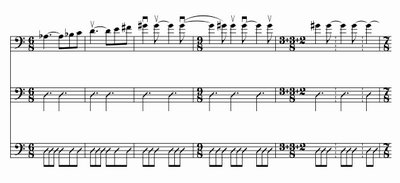
Practicing something like that with a regular metronome is difficult to say the least. I don’t own a Dr. Beat or anything similar, but from what I have seen it wouldn’t be of much help due to the fast tempo and changing meters. To practice this, I created a couple of rhythm tracks in Finale. One with the steady eight notes, the other with the subdivisions Boulez is conducting. Muting the top staff, I practiced first with the other two and then muted the steady eighth notes to see if my own subdividing added up. Once I could play it arco up to speed, I switched to pizz – just for the heck of it. A rude awakening to say the least so I had to back down the tempo and start over.


8 comments:
Wow, that defiantly looks pretty hard for someone who's rhythm isn't exactly their strength. I'm getting stressed just thinking about how to practice that!
Michael, your idea for using finale to practice this is a great one. I don't have a metronome with the capability of programming complex rhythms either. I'm glad you're taking the time to do the blog and appreciate your willingness to share your thoughts about your job and your instrument. Keep up the good work.
Hey Michael- Thanks for the blog. Would you care to expound at some future time on audition preparation? I'd love to hear your ideas and point of view on the subject. Keep up the posting!
Hi Kate - I'm sure the topic will come up. If you have specific questions, please feel free to post them. That would make it easier for me to address issues someone is actually interested in.
Just like the first two measures, it is a measure of 6/8. The beat pattern is in 2 - what the middle staff reflects - so the eigths are beamed that way. In fact, they could have all been beamed together (or not at all) since the bottom staff is continuous eight notes.
Great Blog!! I'm impressed and appreciate the time you have taken to post such detail on pieces. It is inspiring to hear the care and preperation you take with your job and playing.
I'd like to join Kate's call for your thoughts on audition prep. I'm sure I probably speak for the vast majority of us taking orchestra auditions when I say that any opinions from a professional of your stature are not only very interesting but also valuable and inspiring.
Thanks for your blog!
Thanks. Since there is some interest, I will visit the topic of audition preparation sometime soon. Still, if you have specific questions - about specific passages or something more defined than 'auditions' in general, please feel free to post them here. I will do my best to address them. Thanks for reading.
Hello Michael,
This blog of yours is excellent! I really like reading your viewpoints and especially appreciate the excerpts and your approach to performing them - what a fantastic resource!
I also like your approach using your backtrack clicking 8ths to practice. I also discovered this useful learning tool about a year ago and I now practice ALL of my orchestral work using this approach. (In retrospect, I don't know how I ever performed without practicing like this!) - I made a MIDI file that clicks 16ths at 100 beats per minute and I just speed that up or slow it down to whatever tempo I need, so it clicks 8ths if slowed to 50. I also made a file that I call "TImecheck" that will click 8 bars, then leaves out a bar, then play the next bar, etc - which I have found really useful to help me improve my own inner sense of timing.
So Michael - thanks again for the very insightful bass blog!
All the best!
Dave Longenecker (located in a city in Canada)
Post a Comment